Uchronies, Autopsies and Vendette. Jorge Ballester, Memory
and Prospective
|
Uchronies,
Autopsies and Vendette
Jorge
Ballester, Memory and Prospective
From September 20 to December 4, 2011.
Estudi General, Thesaurus and Martínez
Guerricabeitia exhibition rooms - La Nau
From
Tuesday to Saturday, from 10 to 14 and from 16 to 20 h.
Sunday, from 10 to 14 h.
|
|
Visita visual
[+]
|
Catálogo Online [+] |
| |
|
|
|
|
|
|
|
|
|
 |
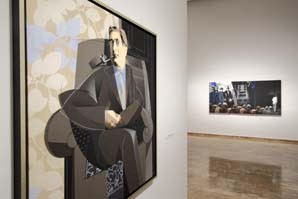 |
|
|
|
EXHIBITION DISCOURSE STRUCTURE
The exhibition discourse is structured into four axes:
|
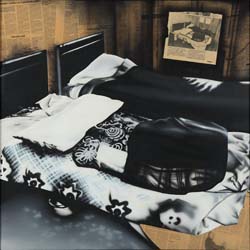 |
A) AT THE END OF REALITY |
|
|
|
|
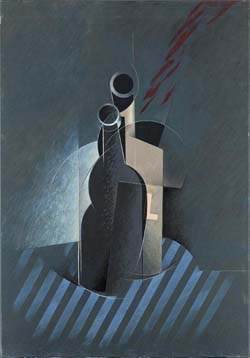 |
B) CUBIST UCHRONIES |
|
|
|
|
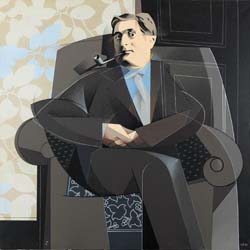 |
C) IDENTITY CARDS |
|
|
|
|
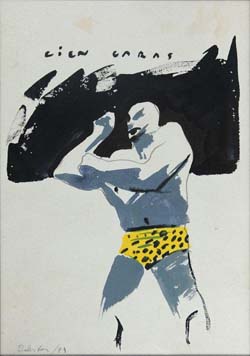 |
D) DEAR MONSTERS |
|
|
|
|
AT THE END OF REALITY
In 1976, Joan Cardells quitted Equipo Realidad.
In the following years, Jorge Ballester continued
working under the same umbrella group. First with
Carrazoni and, finally, on his own. A number of almost
unknown works date back to this period. They close the
cycle of that relevant presence in the history of
Spanish art in the second half of the 20th
century.
A selection of such works makes up the exhibition
introduction. They are a bridge between old Jorge
Ballester –settled down in collective memory, a
relentless witness of leaden days- and new Jorge
Ballester, reborn from his own ashes and willing to
re-design both what could not be and what can
be. |
|
|
|
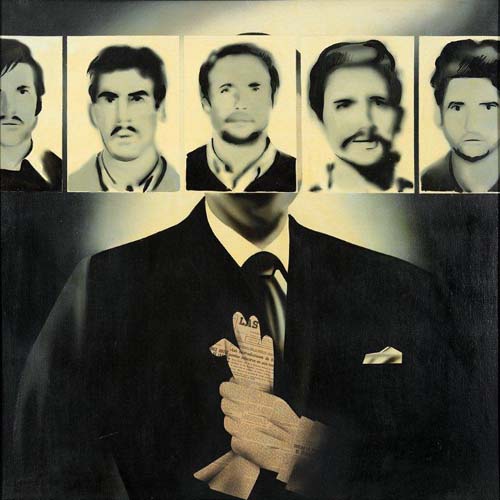
Equipo Realidad: Jorge Ballester and
Enrique Carrazoni.
Untitled C-2, 1977. Acrylic collage
|
|
|
|
CUBIST UCHRONIES
Consisting of sketches, drawings, paintings, sculptures
and a monumental space, Ballester offers a visual
reflection beyond Cubism’s self-imposed limits. |
|
|
|
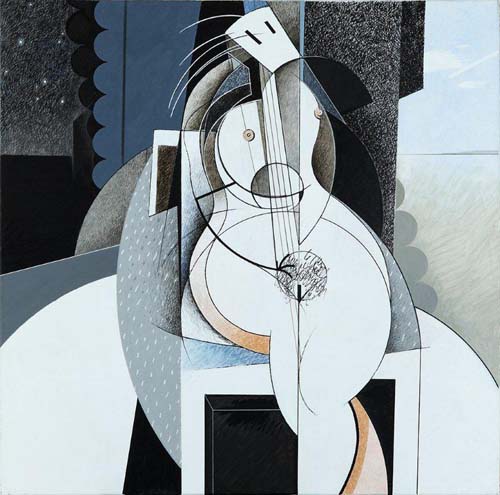
Female sex object scratching her pussy
with her right hand, 2010. Acrylic painting. |
|
|
|
Transposing the limits of Cubism but embedded into its
momentum, jumping from the canvas to the poster,
hybridising the imaginary of the first third of the 20th
century with its continuation, rigorously conjugating
the chemistry of language with semantic alchemy... the
artist unfolds a disciplined but surprising exercise for
the creative subject, similar to that of Cubism.
The critical point is when we are invited to walk into a
three-dimensional still life used by Cubist alternate
history to cannibalise the architectural magnitude of
time, at last. In other words, a still life of habitable
proportions which allowed Cubism to finally show its
long-awaited process vocation. A real
object-container-space surrounds us physically and
mentally, dissolving our status as passive subjects into
it and transforming us into active objects.
IDENTITY CARDS
When
Jorge Ballester is asked what he does for a living, he
usually says he is a “hartista”. “H” for “hartazgo” in
Spanish (to be fed-up). He is fed up with a number of
things, many of them belonging to the art domain, which
apparently keeps operating as if everything were
perfect.
But this irony is nothing but the production of a
conceptual identity card. The identity issue is
particularly concerning for him, as proved by the
gallery of characters of the contemporary aesthetic
adventure put together in this area.
Genuine prospective portraits of figures like Picabia,
Marat, Pauline Bonaparte, Savinio, Beckmann, Pittaluga,
Salmon... all of them subjected to metamorphoses,
substitutions and other exercises through which they
show a not always visible background.
On the other hand, the hypocrisy of the so-called
civilised societies usually causes them to erect
memorials to the Unknown Soldier. Such necrolatries are
genuine ritual exorcisms. They are intended to wash the
blood off the hands and the conscience of those who use
human beings as collateral costs of their capital gains.
Ballester shows us identity cards of anonymous
characters turned into combatants, unknown victims or
comedians who store up, in their undiscovered identity,
causes and sins. This heritage is used to either report
on or pay homage to the miseries and dignity of the
human race, predestined by injustice, paradox and only
rarely by radiant moral alchemy. True revenge. |
|
|
|
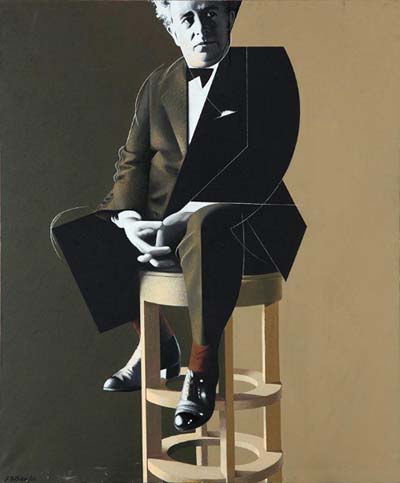
Portrait of Francis Picabia, 2005.
Acrylic painting. |
|
|
|
But Ballester’s political vocation always runs parallel
to his plastic concerns. This is why Identity Cards also
includes deliberate radiographies of our reality. Images
which are already part of a tradition of committed
Spanish Pop. Ballester certainly contributed to this.
The American way of life, Mickey, the loneliness of
human beings in the urban jungle, our political
bestiary... all of them parade in this register of
identities in which the memory of our past, the image of
the present and an alternative vocation merge under the
same optics.
DEAR MONSTERS
The last section suggests a more intimate domain, that
of Ballester's personal mythologies. A peculiar
atmosphere –Mexican wrestling- has been chosen for the
occasion.
With their outrageous and bizarre masks and clothing,
transvestite into comic characters made of papier-mâché
or shabby kabuki characters, though vulnerably human,
the protagonists of this underworld are in contrast with
other caricatures from the world of wrestling.
Their marginal, almost alternative background, and the
peculiar aesthetics are used by Ballester to weave a
microcosm whose connotations shift between a fetishist
atmosphere and a philosophic micro-world. The latter
adjective has been used by contemporary art in other
miniature universes like brothels, the circus, the
artist’s studio, etc. They are all part of an autopsy of
the world and an autopsy of the "hartista" used in his
construction of a peculiar Xanadu. |
|
|
|
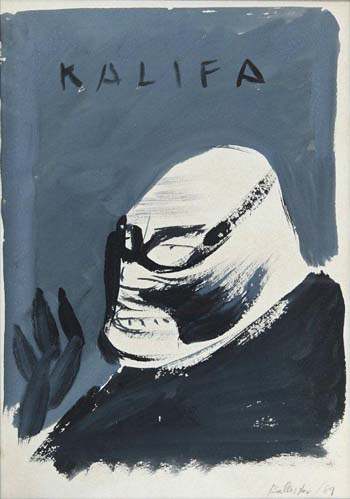
“Caliph”, 1989. Wash drawing |
| |
|
ABOUT THE CATALOGUE
The exhibition is complemented by a catalogue-book which
includes not only the reproduction of the exhibits and a
DVD with the documentary and the installations, but also
a number of assays on their meaning.
SPECIAL EXHIBITION RESOURCES
The exhibition discourse is enriched by the following
special resources:
A) THREE-DIMENSIONAL MONUMENTAL STILL LIFEAs
an extension of the section Cubist Uchronies,
the sample includes a sculptured still life of
monumental dimensions, located at the cloister of La
Nau.
An exempt piece painted in white shows its plastic
contents in relation to the chiaroscuro action of the
light and the viewpoint of visitors, as a result of a
combination of the motion of the sun and the viewers'
position.
B) FOUR VIDEO-INSTALLATIONS
In all four domains, a representative piece is analysed
through an audiovisual resource.
Of a hermeneutic nature and a dialogue-based teaching
approach, four video-installations by Joan Dolç are
projected on the wall. A critical preamble provides
visual, non-narrative data, to encourage the
understanding of the exhibition and a discussion about
the rest of the pieces.
C) DOCUMENTARY
Synopsis and treatment
“Alternate history, Jorge Ballester or memory upside
down” is a documentary feature with a dual goal. On the
one hand, to be a portion of and complement the
exhibition under the same name and, on the other, to be
an autonomous film, one that can show the author's works
to a wide audience in an attractive, suggestive and
clear way but without given up rigour or the complexity
inherent to all the pieces exhibited and to the
exhibition as a whole.
Jorge Ballester’s works are anchored on reality in
various ways. Sometimes directly, in an extremely
explicit manner.... sometimes through mediating elements
from different areas in culture (painting, sculpture,
photography, architecture, etc.) which have previously
dealt with the artistic object in question.
This previous consideration is the starting point and
the documentary axis. At times, his works are like a
mirror facing a piece of reality, or a mirror in front
of a mirror left there by someone, and so on. The
documentary itself operates as yet another mirror in
front of a series of mirrors.
The feature does not use audiovisual language in a
purely descriptive or teaching way, as usual in this
type of documentary, but in a conspiratorial way and
within limits, complementing the artist’s personality
and artwork. |
|
|
|
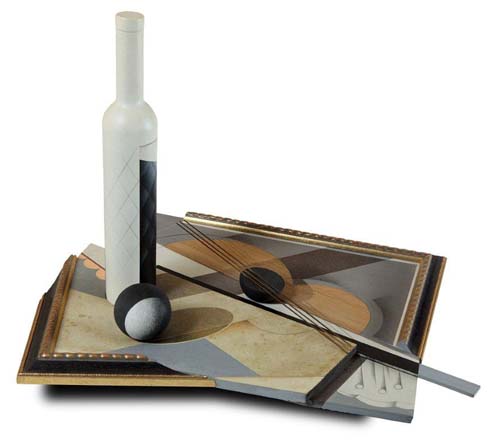
Still life 2, 2008. Polychrome sculpture
in different materials. |
|
|
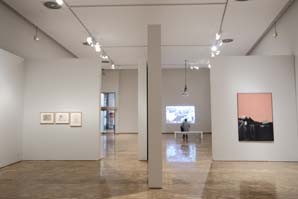 |
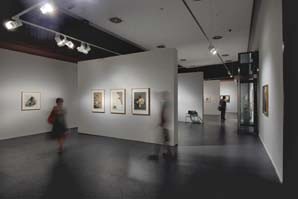 |
|
|
|
|
|
|